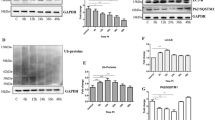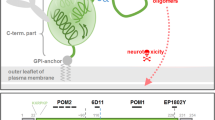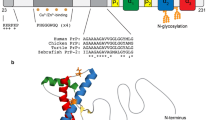Abstract
The biological functions of the cellular prion protein remain poorly understood. In fact, numerous studies have aimed to determine specific functions for the different protein domains. Studies of cellular prion protein (PrPC) domains through in vivo expression of molecules carrying internal deletions in a mouse Prnp null background have provided helpful data on the implication of the protein in signalling cascades in affected neurons. Nevertheless, understanding of the mechanisms underlying the neurotoxicity induced by these PrPC deleted forms is far from complete. To better define the neurotoxic or neuroprotective potential of PrPC N-terminal domains, and to overcome the heterogeneity of results due to the lack of a standardized model, we used neuroblastoma cells to analyse the effects of overexpressing PrPC deleted forms. Results indicate that PrPC N-terminal deleted forms were properly processed through the secretory pathway. However, PrPΔF35 and PrPΔCD mutants led to death by different mechanisms sharing loss of alpha-cleavage and activation of caspase-3. Our data suggest that both gain-of-function and loss-of-function pathogenic mechanisms may be associated with N-terminal domains and may therefore contribute to neurotoxicity in prion disease. Dissecting the molecular response induced by PrPΔF35 may be the key to unravelling the physiological and pathological functions of the prion protein.






Similar content being viewed by others
References
Gorodinsky A, Harris DA (1995) Glycolipid-anchored proteins in neuroblastoma cells form detergent-resistant complexes without caveolin. J Cell Biol 129(3):619–627
Prusiner SB (1982) Novel proteinaceous infectious particles cause scrapie. Science 216(4542):136–144
Riek R, Hornemann S, Wider G, Glockshuber R, Wuthrich K (1997) NMR characterization of the full-length recombinant murine prion protein, mPrP(23-231). FEBS Lett 413(2):282–288
Nicolas O, Gavin R, del Rio JA (2009) New insights into cellular prion protein (PrPc) functions: the "ying and yang" of a relevant protein. Brain Res Rev 61(2):170–184. doi:10.1016/j.brainresrev.2009.06.002
Solomon IH, Schepker JA, Harris DA (2010) Prion neurotoxicity: insights from prion protein mutants. Curr Issues Mol Biol 12(2):51–61
Baumann F, Pahnke J, Radovanovic I, Rulicke T, Bremer J, Tolnay M, Aguzzi A (2009) Functionally relevant domains of the prion protein identified in vivo. PLoS One 4(9), e6707. doi:10.1371/journal.pone.0006707
Baumann F, Tolnay M, Brabeck C, Pahnke J, Kloz U, Niemann HH, Heikenwalder M, Rulicke T et al (2007) Lethal recessive myelin toxicity of prion protein lacking its central domain. EMBO J 26(2):538–547
Shmerling D, Hegyi I, Fischer M, Blattler T, Brandner S, Gotz J, Rulicke T, Flechsig E et al (1998) Expression of amino-terminally truncated PrP in the mouse leading to ataxia and specific cerebellar lesions. Cell 93(2):203–214
Li A, Christensen HM, Stewart LR, Roth KA, Chiesa R, Harris DA (2007) Neonatal lethality in transgenic mice expressing prion protein with a deletion of residues 105-125. EMBO J 26(2):548–558
Nicolas O, Gavin R, Braun N, Urena JM, Fontana X, Soriano E, Aguzzi A, del Rio JA (2007) Bcl-2 overexpression delays caspase-3 activation and rescues cerebellar degeneration in prion-deficient mice that overexpress amino-terminally truncated prion. FASEB J 21(12):3107–3117. doi:10.1096/fj.06-7827com
Li A, Barmada SJ, Roth KA, Harris DA (2007) N-terminally deleted forms of the prion protein activate both Bax-dependent and Bax-independent neurotoxic pathways. J Neurosci 27(4):852–859
Sonati T, Reimann RR, Falsig J, Baral PK, O'Connor T, Hornemann S, Yaganoglu S, Li B et al (2013) The toxicity of antiprion antibodies is mediated by the flexible tail of the prion protein. Nature 501(7465):102–106. doi:10.1038/nature12402nature12402
Klohn PC, Farmer M, Linehan JM, O'Malley C, Fernandez de Marco M, Taylor W, Farrow M, Khalili-Shirazi A et al (2012) PrP antibodies do not trigger mouse hippocampal neuron apoptosis. Science 335(6064):52. doi:10.1126/science.1215579335/6064/52
Gavin R, Braun N, Nicolas O, Parra B, Urena JM, Mingorance A, Soriano E, Torres JM et al (2005) PrP(106-126) activates neuronal intracellular kinases and Egr1 synthesis through activation of NADPH-oxidase independently of PrPc. FEBS Lett 579(19):4099–4106. doi:10.1016/j.febslet.2005.06.037
Mouillet-Richard S, Ermonval M, Chebassier C, Laplanche JL, Lehmann S, Launay JM, Kellermann O (2000) Signal transduction through prion protein. Science 289(5486):1925–1928
Linden R, Martins VR, Prado MA, Cammarota M, Izquierdo I, Brentani RR (2008) Physiology of the prion protein. Physiol Rev 88(2):673–728. doi:10.1152/physrev.00007.2007
Mbazima V, Da Costa Dias B, Omar A, Jovanovic K, Weiss SF (2010) Interactions between PrP(c) and other ligands with the 37-kDa/67-kDa laminin receptor. Front Biosci 15:1150–1163
Parkyn CJ, Vermeulen EG, Mootoosamy RC, Sunyach C, Jacobsen C, Oxvig C, Moestrup S, Liu Q et al (2008) LRP1 controls biosynthetic and endocytic trafficking of neuronal prion protein. J Cell Sci 121(Pt 6):773–783. doi:10.1242/jcs.021816
Warner RG, Hundt C, Weiss S, Turnbull JE (2002) Identification of the heparan sulfate binding sites in the cellular prion protein. J Biol Chem 277(21):18421–18430. doi:10.1074/jbc.M110406200M110406200
Arantes C, Nomizo R, Lopes MH, Hajj GN, Lima FR, Martins VR (2009) Prion protein and its ligand stress inducible protein 1 regulate astrocyte development. Glia 57(13):1439–1449. doi:10.1002/glia.20861
Fioriti L, Dossena S, Stewart LR, Stewart RS, Harris DA, Forloni G, Chiesa R (2005) Cytosolic prion protein (PrP) is not toxic in N2a cells and primary neurons expressing pathogenic PrP mutations. J Biol Chem 280(12):11320–11328. doi:10.1074/jbc.M412441200
Llorens F, Carulla P, Villa A, Torres JM, Fortes P, Ferrer I, del Rio JA (2013) PrP(C) regulates epidermal growth factor receptor function and cell shape dynamics in Neuro2a cells. J Neurochem 127(1):124–138. doi:10.1111/jnc.12283
Enguita M, DeGregorio-Rocasolano N, Abad A, Trullas R (2005) Glycogen synthase kinase 3 activity mediates neuronal pentraxin 1 expression and cell death induced by potassium deprivation in cerebellar granule cells. Mol Pharmacol 67(4):1237–1246. doi:10.1124/mol.104.007062
Vilches S, Vergara C, Nicolas O, Sanclimens G, Merino S, Varon S, Acosta GA, Albericio F et al (2013) Neurotoxicity of prion peptides mimicking the central domain of the cellular prion protein. PLoS One 8(8):e70881. doi:10.1371/journal.pone.0070881PONE-D-13-04002
Legler DF, Doucey MA, Schneider P, Chapatte L, Bender FC, Bron C (2005) Differential insertion of GPI-anchored GFPs into lipid rafts of live cells. FASEB J 19(1):73–75. doi:10.1096/fj.03-1338fje
Bindokas VP, Jordan J, Lee CC, Miller RJ (1996) Superoxide production in rat hippocampal neurons: selective imaging with hydroethidine. J Neurosci 16(4):1324–1336
Gil V, del Rio JA (2012) Analysis of axonal growth and cell migration in 3D hydrogel cultures of embryonic mouse CNS tissue. Nat Protoc 7(2):268–280. doi:10.1038/nprot.2011.445
Nocentini S, Reginensi D, Garcia S, Carulla P, Moreno-Flores MT, Wandosell F, Trepat X, Bribian A et al (2012) Myelin-associated proteins block the migration of olfactory ensheathing cells: an in vitro study using single-cell tracking and traction force microscopy. Cell Mol Life Sci 69(10):1689–1703. doi:10.1007/s00018-011-0893-1
Gurtu V, Kain SR, Zhang G (1997) Fluorometric and colorimetric detection of caspase activity associated with apoptosis. Anal Biochem 251(1):98–102. doi:10.1006/abio.1997.2220
Pan T, Li R, Wong BS, Liu T, Gambetti P, Sy MS (2002) Heterogeneity of normal prion protein in two-dimensional immunoblot: presence of various glycosylated and truncated forms. J Neurochem 81(5):1092–1101
Harris DA, Huber MT, van Dijken P, Shyng SL, Chait BT, Wang R (1993) Processing of a cellular prion protein: identification of N- and C-terminal cleavage sites. Biochemistry 32(4):1009–1016
Chen SG, Teplow DB, Parchi P, Teller JK, Gambetti P, Autilio-Gambetti L (1995) Truncated forms of the human prion protein in normal brain and in prion diseases. J Biol Chem 270(32):19173–19180
Naslavsky N, Stein R, Yanai A, Friedlander G, Taraboulos A (1997) Characterization of detergent-insoluble complexes containing the cellular prion protein and its scrapie isoform. J Biol Chem 272(10):6324–6331
Kwiatkowska K, Frey J, Sobota A (2003) Phosphorylation of FcgammaRIIA is required for the receptor-induced actin rearrangement and capping: the role of membrane rafts. J Cell Sci 116(Pt 3):537–550
Taylor DR, Watt NT, Perera WS, Hooper NM (2005) Assigning functions to distinct regions of the N-terminus of the prion protein that are involved in its copper-stimulated, clathrin-dependent endocytosis. J Cell Sci 118(Pt 21):5141–5153. doi:10.1242/jcs.02627
Solomon IH, Huettner JE, Harris DA (2010) Neurotoxic mutants of the prion protein induce spontaneous ionic currents in cultured cells. J Biol Chem 285(34):26719–26726. doi:10.1074/jbc.M110.134619M110.134619
Solomon IH, Khatri N, Biasini E, Massignan T, Huettner JE, Harris DA (2011) An N-terminal polybasic domain and cell surface localization are required for mutant prion protein toxicity. J Biol Chem 286(16):14724–14736. doi:10.1074/jbc.M110.214973
Rossi D, Cozzio A, Flechsig E, Klein MA, Rulicke T, Aguzzi A, Weissmann C (2001) Onset of ataxia and Purkinje cell loss in PrP null mice inversely correlated with Dpl level in brain. EMBO J 20(4):694–702
Sakaguchi S, Katamine S, Nishida N, Moriuchi R, Shigematsu K, Sugimoto T, Nakatani A, Kataoka Y et al (1996) Loss of cerebellar Purkinje cells in aged mice homozygous for a disrupted PrP gene. Nature 380(6574):528–531
Moore RC, Mastrangelo P, Bouzamondo E, Heinrich C, Legname G, Prusiner SB, Hood L, Westaway D et al (2001) Doppel-induced cerebellar degeneration in transgenic mice. Proc Natl Acad Sci U S A 98(26):15288–15293
Schubert D, Humphreys S, Baroni C, Cohn M (1969) In vitro differentiation of a mouse neuroblastoma. Proc Natl Acad Sci U S A 64(1):316–323
Alais S, Simoes S, Baas D, Lehmann S, Raposo G, Darlix JL, Leblanc P (2008) Mouse neuroblastoma cells release prion infectivity associated with exosomal vesicles. Biol Cell 100(10):603–615. doi:10.1042/BC20080025
Rangel A, Burgaya F, Gavin R, Soriano E, Aguzzi A, Del Rio JA (2007) Enhanced susceptibility of Prnp-deficient mice to kainate-induced seizures, neuronal apoptosis, and death: Role of AMPA/kainate receptors. J Neurosci Res 85(12):2741–2755. doi:10.1002/jnr.21215
Mange A, Beranger F, Peoc'h K, Onodera T, Frobert Y, Lehmann S (2004) Alpha- and beta- cleavages of the amino-terminus of the cellular prion protein. Biol Cell 96(2):125–132. doi:10.1016/j.biolcel.2003.11.007S0248490004000061
Oliveira-Martins JB, Yusa S, Calella AM, Bridel C, Baumann F, Dametto P, Aguzzi A (2010) Unexpected tolerance of alpha-cleavage of the prion protein to sequence variations. PLoS One 5(2), e9107. doi:10.1371/journal.pone.0009107
McDonald AJ, Millhauser GL (2014) PrP overdrive: does inhibition of alpha-cleavage contribute to PrP(C) toxicity and prion disease? Prion 8 (2). doi:28796 [pii]
Beland M, Roucou X (2012) The prion protein unstructured N-terminal region is a broad-spectrum molecular sensor with diverse and contrasting potential functions. J Neurochem 120(6):853–868. doi:10.1111/j.1471-4159.2011.07613.x
Guillot-Sestier MV, Sunyach C, Druon C, Scarzello S, Checler F (2009) The alpha-secretase-derived N-terminal product of cellular prion, N1, displays neuroprotective function in vitro and in vivo. J Biol Chem 284(51):35973–35986. doi:10.1074/jbc.M109.051086M109.051086
Lauren J, Gimbel DA, Nygaard HB, Gilbert JW, Strittmatter SM (2009) Cellular prion protein mediates impairment of synaptic plasticity by amyloid-beta oligomers. Nature 457(7233):1128–1132. doi:10.1038/nature07761
Solforosi L, Bellon A, Schaller M, Cruite JT, Abalos GC, Williamson RA (2007) Toward molecular dissection of PrPC-PrPSc interactions. J Biol Chem 282(10):7465–7471. doi:10.1074/jbc.M610051200
Westergard L, Turnbaugh JA, Harris DA (2011) A nine amino acid domain is essential for mutant prion protein toxicity. J Neurosci 31(39):14005–14017. doi:10.1523/JNEUROSCI.1243-11.2011
Massignan T, Biasini E, Harris DA (2011) A drug-based cellular assay (DBCA) for studying cytotoxic and cytoprotective activities of the prion protein: a practical guide. Methods 53(3):214–219. doi:10.1016/j.ymeth.2010.11.005
Katamine S, Nishida N, Sugimoto T, Noda T, Sakaguchi S, Shigematsu K, Kataoka Y, Nakatani A et al (1998) Impaired motor coordination in mice lacking prion protein. Cell Mol Neurobiol 18(6):731–742
Heitz S, Gautheron V, Lutz Y, Rodeau JL, Zanjani HS, Sugihara I, Bombarde G, Richard F et al (2008) BCL-2 counteracts Doppel-induced apoptosis of prion-protein-deficient Purkinje cells in the Ngsk Prnp(0/0) mouse. Dev Neurobiol 68(3):332–348
Heitz S, Lutz Y, Rodeau JL, Zanjani H, Gautheron V, Bombarde G, Richard F, Fuchs JP et al (2007) BAX contributes to Doppel-induced apoptosis of prion-protein-deficient Purkinje cells. Dev Neurobiol 67(5):670–686
Herrmann US, Sonati T, Falsig J, Reimann RR, Dametto P, O'Connor T, Li B, Lau A et al (2015) Prion infections and anti-PrP antibodies trigger converging neurotoxic pathways. PLoS Pathog 11(2), e1004662. doi:10.1371/journal.ppat.1004662PPATHOGENS-D-14-01363
Acknowledgments
The authors thank Prof. D. Harris (University of Boston) for kindly providing pcDNA-PrP plasmid and Prof. A. Aguzzi (University Hospital of Zurich) for pcDNA-ΔF35 plasmid. The authors thank Tom Yohannan for the editorial advice, M. Martínez-Vicente from M. Vila’s Lab for her guidance in MMP experiments, and M. Segura for the technical assistance. This research was supported by the Spanish Ministry of Science and Innovation (BFU2012-32617), FP7-PRIORITY, the Generalitat de Catalunya (SGR2014-1218), CIBERNED (PI2014/02-4 and PRY-14-114), La Caixa Obra Social Foundation, La Marató de TV3, and the Basque Foundation of Health and Innovation Research (BIO12/AL/004) to JADR. R.G. was supported by Instituto de Salud Carlos Tercero (FIS, PI11-00075). C.V, S.V., and A.M. were supported by the Spanish Ministry of Science and Innovation. O.N. was supported by Fundación Ramón Areces.
Author information
Authors and Affiliations
Corresponding authors
Electronic Supplementary Material
Below is the link to the electronic supplementary material.
Suppl Fig. 1
Quantitative assay of caspase-3 activity in transiently transfected N2A cells. Bars represent the mean ± SEM of three independent experiments (* p < 0.05, ** p < 0.01, versus empty-vector transfected cells). (JPEG 147 kb)
Suppl Fig. 2
Separation of PrPC-deleted forms PrPΔCC, PrPΔHR, and PrPΔCR in sucrose gradient. Fractions 1-12 of the sucrose density gradient were analysed with Western blotting. Flotillin (48-kDa) was used as a marker of lipid rafts. Blots are representative of three independent experiments. (JPEG 113 kb)
Suppl Fig. 3
Micrographs of transiently transfected N2A cells with N-terminal deleted forms PrPΔCC, PrPΔHR, PrPΔCR, and the empty vector pCDNA labeled with specific marker for ER (Sec61, red) for co-localization with PrP forms (6H4-green). (JPEG 186 kb)
Suppl Fig. 4
Micrographs of transiently transfected N2A cells with N-terminal deleted forms PrPΔCC, PrPΔHR, PrPΔCR, and the empty vector pCDNA labeled with specific marker for early endosomes (EEA1, red) for co-localization with PrP forms (6H4-green). (JPEG 161 kb)
Suppl Fig. 5
Micrographs of transiently transfected N2A cells with N-terminal deleted forms PrPΔCC, PrPΔHR, PrPΔCR, and the empty vector pCDNA labeled with specific marker for recycling endosomes (Rab4, red) for co-localization with PrP forms (6H4-green). (JPEG 168 kb)
Suppl Fig. 6
Quantitative assay of mitochondrial membrane depolarization in transiently transfected N2A cells. Bars represent the mean ± SEM of two independent experiments (* p < 0.05 versus empty-vector transfected cells). (JPEG 53 kb)
Rights and permissions
About this article
Cite this article
Vilches, S., Vergara, C., Nicolás, O. et al. Domain-Specific Activation of Death-Associated Intracellular Signalling Cascades by the Cellular Prion Protein in Neuroblastoma Cells. Mol Neurobiol 53, 4438–4448 (2016). https://doi.org/10.1007/s12035-015-9360-6
Received:
Accepted:
Published:
Issue Date:
DOI: https://doi.org/10.1007/s12035-015-9360-6




